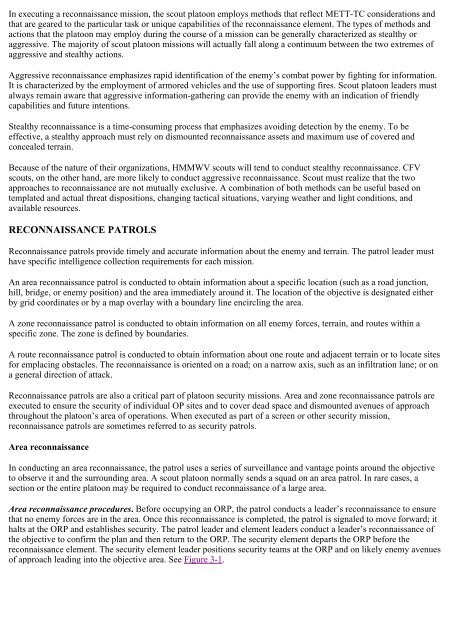FM 17-98 SCOUT PLATOON
FM 17-98 SCOUT PLATOON
FM 17-98 SCOUT PLATOON
Create successful ePaper yourself
Turn your PDF publications into a flip-book with our unique Google optimized e-Paper software.
In executing a reconnaissance mission, the scout platoon employs methods that reflect METT-TC considerations and<br />
that are geared to the particular task or unique capabilities of the reconnaissance element. The types of methods and<br />
actions that the platoon may employ during the course of a mission can be generally characterized as stealthy or<br />
aggressive. The majority of scout platoon missions will actually fall along a continuum between the two extremes of<br />
aggressive and stealthy actions.<br />
Aggressive reconnaissance emphasizes rapid identification of the enemy’s combat power by fighting for information.<br />
It is characterized by the employment of armored vehicles and the use of supporting fires. Scout platoon leaders must<br />
always remain aware that aggressive information-gathering can provide the enemy with an indication of friendly<br />
capabilities and future intentions.<br />
Stealthy reconnaissance is a time-consuming process that emphasizes avoiding detection by the enemy. To be<br />
effective, a stealthy approach must rely on dismounted reconnaissance assets and maximum use of covered and<br />
concealed terrain.<br />
Because of the nature of their organizations, HMMWV scouts will tend to conduct stealthy reconnaissance. CFV<br />
scouts, on the other hand, are more likely to conduct aggressive reconnaissance. Scout must realize that the two<br />
approaches to reconnaissance are not mutually exclusive. A combination of both methods can be useful based on<br />
templated and actual threat dispositions, changing tactical situations, varying weather and light conditions, and<br />
available resources.<br />
RECONNAISSANCE PATROLS<br />
Reconnaissance patrols provide timely and accurate information about the enemy and terrain. The patrol leader must<br />
have specific intelligence collection requirements for each mission.<br />
An area reconnaissance patrol is conducted to obtain information about a specific location (such as a road junction,<br />
hill, bridge, or enemy position) and the area immediately around it. The location of the objective is designated either<br />
by grid coordinates or by a map overlay with a boundary line encircling the area.<br />
A zone reconnaissance patrol is conducted to obtain information on all enemy forces, terrain, and routes within a<br />
specific zone. The zone is defined by boundaries.<br />
A route reconnaissance patrol is conducted to obtain information about one route and adjacent terrain or to locate sites<br />
for emplacing obstacles. The reconnaissance is oriented on a road; on a narrow axis, such as an infiltration lane; or on<br />
a general direction of attack.<br />
Reconnaissance patrols are also a critical part of platoon security missions. Area and zone reconnaissance patrols are<br />
executed to ensure the security of individual OP sites and to cover dead space and dismounted avenues of approach<br />
throughout the platoon’s area of operations. When executed as part of a screen or other security mission,<br />
reconnaissance patrols are sometimes referred to as security patrols.<br />
Area reconnaissance<br />
In conducting an area reconnaissance, the patrol uses a series of surveillance and vantage points around the objective<br />
to observe it and the surrounding area. A scout platoon normally sends a squad on an area patrol. In rare cases, a<br />
section or the entire platoon may be required to conduct reconnaissance of a large area.<br />
Area reconnaissance procedures. Before occupying an ORP, the patrol conducts a leader’s reconnaissance to ensure<br />
that no enemy forces are in the area. Once this reconnaissance is completed, the patrol is signaled to move forward; it<br />
halts at the ORP and establishes security. The patrol leader and element leaders conduct a leader’s reconnaissance of<br />
the objective to confirm the plan and then return to the ORP. The security element departs the ORP before the<br />
reconnaissance element. The security element leader positions security teams at the ORP and on likely enemy avenues<br />
of approach leading into the objective area. See Figure 3-1.











